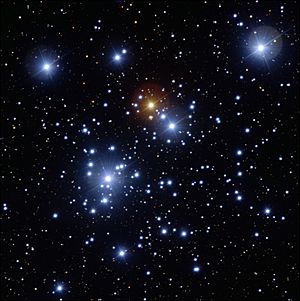Caldwell catalogue facts for kids

The Caldwell catalogue is a special list of 109 amazing things you can see in space. It includes sparkling groups of stars called star clusters, colorful clouds of gas and dust called nebulae, and huge groups of stars called galaxies. This list was made for people who love looking at the night sky with telescopes, also known as amateur astronomers. It was put together by a famous English astronomer named Patrick Moore.
Why was the Caldwell Catalogue created?
There is another well-known list for skygazers called the Messier catalogue. Amateur astronomers often use it to find interesting objects in the deep sky. However, the Messier catalogue was not originally made for this purpose. It was created by French astronomer Charles Messier to list objects that looked like comets but were not. This helped him avoid confusing them with real comets.
Because of how it was made, the Messier catalogue misses many bright and beautiful objects in the sky. For example, it does not include the Hyades or the Double Cluster (NGC 869 and NGC 884). It also does not feature the Sculptor Galaxy (NGC 253).
Missing objects from the Southern Hemisphere
Charles Messier made his list from observations he did in Paris, France. This meant his list did not include bright deep-sky objects that are only visible from the Southern Hemisphere. These amazing sights include Omega Centauri, Centaurus A, the Jewel Box, and 47 Tucanae.
So, Patrick Moore decided to create a new list. He wanted it to include these missing, bright objects. He made sure his list had 109 objects, matching the number of objects in the Messier catalogue at the time. The Caldwell catalogue was first published in a magazine called Sky & Telescope in December 1995.
See also
 In Spanish: Catálogo Caldwell para niños
In Spanish: Catálogo Caldwell para niños

